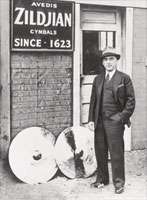Avedis Zildjian Company
The Avedis Zildjian Company, simply known as Zildjian (/ˈzɪldʒən, -dʒiən/),[1] is an Armenian-American musical instrument manufacturer and the largest cymbal and drumstick maker in the world. The company was founded in Constantinople (present-day Istanbul, Turkey) by Avedis Zildjian in 1623, and is now based in Norwell, Massachusetts. Zildjian is one of the oldest manufacturers of musical instruments in the world. Zildjian sells cymbals, drumsticks, percussion mallets and other drum accessories under the Zildjian, Vic Firth and Balter Mallet brands.[2][3][4][5][6][7]
 | |
| Private | |
| Industry | Musical Instruments |
| Founded | Constantinople, Ottoman Empire (1623) |
| Founder | Avedis Zildjian |
| Headquarters | , U.S. |
Key people |
|
| Products | Cymbals, Drumsticks |
| Owners |
|
| Website | zildjian |
History
Beginnings
The first Zildjian cymbals were created in 1618 by Avedis Zildjian, an Armenian metalsmith and alchemist.[8] Like his father, who was also a metalsmith, he worked for the court of the Sultan of the Ottoman Empire in Constantinople.[9] He made an alloy of tin, copper, and silver into a sheet of metal, which could make musical sounds without shattering.[10] According to the company's website, the Sultan Osman II the Young gave Avedis the name Zildjian, meaning "cymbal smith" in Armenian, with zil being Turkish for "cymbal," ci meaning "maker", and ian being the Armenian suffix meaning "son of".[11] In 1623 the Sultan granted him permission to leave the palace to start his own business in a suburb of Constantinople named Psamatia.[11][12]
Zildjian's shop manufactured cymbals for the mehter, Ottoman military bands consisting of wind and percussion instruments, which belonged to the Janissaries. Mehter ensembles, which were known in the West primarily for playing in battle, also performed courtly music for Ottoman rulers.[8][13][14] The Zildjians likely also produced instruments for Greek and Armenian churches, Sufi dervishes, and belly dancers of the Ottoman harem, who wore finger cymbals.[8]
After the death of Avedis, the business, and the secret for producing the metal, was handed down to several generations of male heirs. In the early 19th century, Haroutune Zildjian passed it on to his son Avedis II.[9] In 1850, Avedis II built a 25-foot schooner, in order to sail cymbals produced in Constantinople to trade exhibitions such as the Great Exhibition in London,[8] and to supply musicians in Europe.[15][16] He died in 1865, and since his sons were too young, his brother Kerope II took over the company.[17] He introduced a line of instruments called K Zildjian, which are used by classical musicians to this day.[8][18] Kerope II died in 1909 in Constantinople.[17]
1900s
Kerope II had no sons, so the business returned to the now-grown sons of Avedis II. The eldest, Haroutune II, had become a lawyer and held a high position in the Ottoman government, thus he was not interested. It passed to Aram, who was known as a playboy and rabble-rouser. He was involved in the Armenian nationalist movement and resistance to the atrocities of the ruling Sultan, Abdul Hamid II. After being implicated in a 1905 failed plot to assassinate the Sultan, he fled to Bucharest, where he set up a small foundry.[19][20][21][11]
During Aram's exile, Kerope II's daughter Victoria oversaw the Constantinople factory. There are conflicting accounts, but it is thought that Aram returned there in 1926.[9]

Haroutune II's son Avedis III had left Turkey for the United States in 1908, and settled in Boston, where he established a family and a confectionary business.[16][22] Sometime around 1927, he received a letter from his uncle Aram, informing him that he was to become heir to the family business, and Aram came to the US.[16] Around 1928, Avedis III, his brother Puzant, and his uncle Aram Zildjian began manufacturing cymbals in Quincy, Massachusetts,[23][24] and the Avedis Zildjian Co. was formed the following year in 1929.[25]
Avedis III sought out jazz drummers like Gene Krupa to understand their needs.[26] The new cymbals he developed were widely adopted by swing and later bebop musicians, laying the foundations of the modern drum kit and playing technique.[8]
Sales of Zildjian cymbals increased after Ringo Starr used the product in The Beatles' appearance on The Ed Sullivan Show.[27]
In 1968, Avedis split production into two separate operations, opening the Azco factory in Meductic, New Brunswick, Canada.[28]

In 1975, Zildjian began making K. Zildjian cymbals at the Azco plant.[29] These were made until 1979. Within four years (1980), all K Cymbals were being made in the Norwell US plant, because the Ks demanded far more oversight. Armand worked with friends, the drummers Elvin Jones and Tony Williams to relaunch the K Series.
In early 1977, Armand Zildjian was appointed President of the Avedis Zildjian Company by his father.[30] Soon after, Robert Zildjian split from the company amidst conflict with his brother, Armand. In 1981, Robert started making Sabian cymbals in the Canadian Azco factory.[31]
Recent history
In 2002, Armand died at age 81. The Zildjian alloy recipe passed to his daughters, Craigie and Debbie (14th generation), both of whom continue to run the family business from the current factory in Norwell, Massachusetts.[30][32]
In 2010, Zildjian acquired the Vic Firth Company and in 2018 acquired the Mike Balter Mallet company expanding the company's product offerings to include a full range of drumsticks and percussion mallets.
See also
- List of oldest companies
- Sabian – Cymbal maker founded by Robert Zildjian after a family/legal dispute
- List of drum makers
References
- "Pronunciation of zildjian". howjsay.com. Retrieved 2010-12-21.
- Robert Kreitner, Carlene M. Cassidy (2011). Management (12th ed.). Mason, OH: South-Western Cengage. p. 35. ISBN 9781111221362.
Company, based in Norwell, Massachusetts, is the largest cymbal maker in the world and the oldest continuously family-run business in the United States.
- Lamb, Charles W. (2002). The Subject is Marketing (2nd Canadian ed.). Scarborough, Ont.: Nelson Thomson Learning. p. 26. ISBN 9780176169558.
Avedis Zildjian of Norwell, Massachusetts, can trace its history back to 1623 in Constantinople. It is the world's largest maker of cymbals for drummers and musicians.
- Newsweek, Volume 71, Issues 1-9, 1968, p. 71 "As the only producer of cymbals in the U.S., the Zildjian company dominates a world market rapidly expanding with the proliferation of per- cussionary rock 'n' roll bands."
- The Music Trades, Volume 135, Issues 1-6, p. 90 "Maintaining its position as the world's largest cymbal producer, the Avedis Zildjian Company has announced an exciting joint venture with Barcus-Berry, Inc."
- "Robert Zildjian Dead: Founder Of Sabian Cymbal Company Dies At 89". The Huffington Post. 29 March 2013. Retrieved 25 May 2013.
- "Vic Firth Company and Avedis Zildjian Company Announce Merger". VicFirth.com. Archived from the original on 2010-12-22. Retrieved 2010-12-21.
- Lara Pellegrinelli (Aug 3, 2018). "A Family's 400-Year-Old Musical Secret Still Rings True". New York Times. Retrieved 2018-08-04.
- Cohan, Jon (1999). Zildjian: A History of the Legendary Cymbal Makers. Hal Leonard Corporation. pp. 7–11. ISBN 978-0-7935-9154-1 – via Google Books.
- Charles C. Sharpe (1 November 1999). Patent, Trademark, and Copyright Searching on the Internet. McFarland. pp. 71–. ISBN 978-0-7864-6261-2.
- "The Zildjian Brand Journey". Zildjian. Retrieved 6 June 2020.
- Down Beat. Maher Publications. 1977.
- The Middle East. IC Publications Limited. 1986.
- SPIN Media LLC (May 1989). SPIN. SPIN Media LLC. pp. 19–. ISSN 0886-3032.
- The School Musician Director and Teacher. Ammark Publishing Company. 1973.
- Dev Patnaik; Peter Mortensen (2009). Wired to Care: How Companies Prosper when They Create Widespread Empathy. FT Press. pp. 52–. ISBN 978-0-13-714234-7.
- Percussive Notes. Percussive Arts Society. 2008.
- The Trade-mark Reporter. United States Trademark Association. 1953.
- Woodwind World-brass & Percussion. Evans Publications. 1975.
When it came time to hand down the secret, Kerope had no sons, which resulted in his returning the secret to the sons of Avedis II who by then were old enough to carry on the tradition. Haroutian, who had since become a lawyer, was holding a high post equivalent to Attorney General for Turkey, consequently uninterested. The privilege was then passed to Aram, also a colorful figure in government but for different reasons. Aram was involved with the Armenian underground implicated with attempts to assassinate a powerful and dreaded sultan. The attempt failed and resulted in his fleeing to Bucharest, Rumania.
- Aldridge, John (1994). Guide to Vintage Drums. Hal Leonard Corporation. ISBN 978-0-931759-79-6 – via Google Books.
- Flagler, J. M. (6 December 1958). "A Far Cry from the Corybantes". The New Yorker. Retrieved 2020-06-30.
- Anwar, Syed Tariq; Anwar, Susan Martin (September 2011). "Evolution of entrepreneurship and organizational configurations at Zildjian, 1623–2010". Journal of International Entrepreneurship. 9 (3): 128. doi:10.1007/s10843-011-0076-z.
- Percussive Notes. Percussive Arts Society. 1965.
- Music Trades. Music Trades Corporation. 1983.
- The United States Patents Quarterly. Associated Industry Publications. 1957.
- Modern Drummer: MD. Modern Drummer Publications. 2001.
- "Last week's trivia answer". Florida Weekly. June 26, 2019. Retrieved July 4, 2019 – via The Motley Fool.
- James Holland (16 September 2005). Practical Percussion: A Guide to the Instruments and Their Sources. Scarecrow Press. pp. 84ff. ISBN 978-1-4616-7063-6.
- Modern Drummer: MD. Modern Drummer Publications. 1992.
- "Armand Zildjian, 81, Led Cymbal Company".
- "Robert Zildjian". The Telegraph. 2 Apr 2013. Retrieved 14 May 2020.
- Dotson, Bob (March 6, 2013). "How a 390-year-old family business avoids layoffs". Today. Retrieved August 13, 2020.